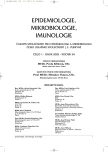HCV Genotyping by Combination of Cobas Amplicor HCV 2.0 Test and Versant HCV Genotype Assay
Vyšetření genotypu HCV pomocí kombinace testu Cobas Amplicor HCV 2.0 a reverzní hybridizace Versant HCV Genotype Assay
Genotypizace viru hepatitidy C /HCV)má význam zejména pro stanovení schématu léčby pacientů s chronickou VHC a pro prognózu úspěšnosti léčby. U souboru 62 sér pozitivních na HCV RNA v testu Cobas Amplicor HCV 2.0 (CA) byl zjišťován genotyp HCV metodou reverzní hybridizace (Versant HCV Genotype Assay (LiPA) Bayer), modifikovanou tím způsobem, že jako výchozí amplifikovaný materiál pro reakci byl použit přímo produkt CA. Z 57 vzorků (92 %) reaktivních v reverzní hybridizaci byl u 56 určen genotyp. U jednoho vzorku neodpovídal profil žádnému určitému genotypu, pět vzorků bylo nereaktivních a jeden nebyl v tomto uspořádání testován. U dvou z těchto 5 nereaktivních a u jednoho netestovaného séra byl určen genotyp reverzní hybridizací vycházející z nested PCR. Lze shrnout, že produkt získaný po jednostupňové amplifikaci HCV RNA v testu CA je pro většinu vzorků vhodným výchozím materiálem pro genotypizaci reverzní hybridizací. Pro laboratoře používající k detekci HCV RNA v séru Cobas Amplicor HCV 2.0 by tento postup vedl ke zjednodušení genotypizace a k časové a materiálové úspoře. U sér s nižší koncentrací viru, která nejsou typizovatelná touto kombinací metod, lze vycházet z nested PCR. Čtyřicet osm vybraných vzorků bylo typizováno vedle reverzní hybridizace také sérologicky soupravou Murex HCV Serotyping 1–6 Assay (Abbot Murex). Typ byl určen u 37 ze 48 testovaných sér (77 %) včetně všech tří sér negativních v reverzní hybridizaci. Přestože je sérologická typizace méně citlivá, může být významná při typizaci některých sér s nízkou hladinou HCV RNA a sér neobsahujících již detekovatelnou virovou NK, která nejsou typizovatelná reverzní hybridizací. U 33 sér, jež byla genotypovatelná oběma metodami, byly tyto metody ve vzájemné shodě. Pouze ve dvou případech zjistila sérologická metoda přítomnost jednoho typu viru navíc (smíšený genotyp) oproti reverzní hybridizaci.
Klíčová slova:
genotypizace HCV – reverzní hybridizace – sérotypizace.
Authors:
J. Němcová; V. Němeček
Authors‘ workplace:
NRL pro virové hepatitidy, SZÚ Praha
Published in:
Epidemiol. Mikrobiol. Imunol. 54, 2005, č. 1, s. 34-38
Overview
Genotyping of hepatitis C virus (HCV) is of relevance to scheduling the treatment of patients with chronic hepatitis C (VHC), making their prognosis and monitoring the treatment efficacy. A set of 62 sera testing HCV RNA positive in Cobas Amplicor HCV 2.0 test (CA) were genotyped using Versant HCV Genotype Assay (LiPA) Bayer, i.e. the reverse hybridization method, with the CA amplified product being directly used in the assay. Fifty-six out of 57 samples reactive in reverse hybridization (92 %) were genotyped. One sample showed a profile differing from any genotype, five samples were not reactive and one sample was not tested within this study design. Two out of five non-reactive sera and one non-tested serum could be genotyped by nested PCR based reverse hybridization. It can be concluded that the CA product resulting from one-step HCV RNA amplification is suitable for use in genotyping by reverse hybridization. The CA product based genotyping procedure is easier to perform, less time-consuming and less costly. The nested PCR based procedure could be used for typing of sera with lower HCV concentrations nontypeable with the combination of CA and Versant HCV Genotype Assay. Forty-eight selected samples were typed not only by reverse hybridization but also by a serological kit Murex HCV Serotyping 1–6 Assay (Abbot Murex). Thirty-seven (77 %) of these sera, including all of three sera negative in reverse hybridization, appeared typeable by this kit. Although less sensitive, serotyping may be of relevance to typing of sera with low HCV levels or not containing detectable viral NA which are nontypeable by reverse hybridization. Thirty-three sera appeared genotypeable by both of the methods tested with the results being in good agreement. In two cases only the serotyping method revealed one more type of virus (mixed genotype) compared to the reverse hybridization.
Key words:
HCV genotyping – reverse hybridization – serotyping.
Labels
Hygiene and epidemiology Medical virology Clinical microbiologyArticle was published in
Epidemiology, Microbiology, Immunology

2005 Issue 1
Most read in this issue
- Inhibition of Hemolytic Activity of Staphylococcus aureus β-hemolysin by an Exosubstance Produced by some Enterococcus faecalis Strains
- HCV Genotyping by Combination of Cobas Amplicor HCV 2.0 Test and Versant HCV Genotype Assay
- Longitudinal Epidemiology of Leptospirosis in the Czech Republic (1963–2003)
- Poliomyelitis Surveillance in the Czech Republic from the Start of Vaccination to the Certification of Eradication in the European Region
